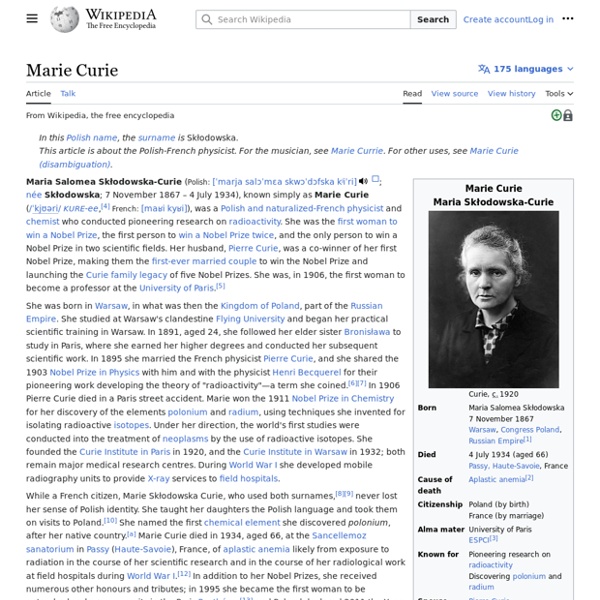Shadow
Area where direct light from a light source cannot reach due to obstruction by an object Shadows of visitors to the Eiffel Tower, viewed from the first platform Park fence shadow is distorted by an uneven snow surface Point and non-point light sources[edit]
Animal
Kingdom of motile multicellular eukaryotic heterotrophic organisms Most living animal species are in Bilateria, a clade whose members have a bilaterally symmetric body plan. The Bilateria include the protostomes—in which many groups of invertebrates are found, such as nematodes, arthropods, and molluscs—and the deuterostomes, containing both the echinoderms as well as the chordates, the latter containing the vertebrates. Life forms interpreted as early animals were present in the Ediacaran biota of the late Precambrian.
Manchineel
Poisonous plant from tropical North and South America The manchineel tree (Hippomane mancinella) is a species of flowering plant in the spurge family (Euphorbiaceae). Its native range stretches from tropical southern North America to northern South America.[3]
M-DISC
M-DISC (Millennial Disc) is a write-once optical disc technology introduced in 2009 by Millenniata, Inc.[1] and available as DVD and Blu-ray discs.[2] Overview[edit] M-DISC's design is intended to provide greater archival media longevity.[3][4] Millenniata claims that properly stored M-DISC DVD recordings will last 1000 years.[5] The M-DISC DVD looks like a standard disc, except it is slightly thicker and almost transparent.
Telomerase
Tribolium castaneum telomerase catalytic subunit, TERT, bound to putative RNA template and telomeric DNA (PDB 3KYL) The existence of a compensatory mechanism for telomere shortening was first predicted by Soviet or Russian biologist Alexey Olovnikov in 1973,[2] who also suggested the telomere hypothesis of aging and the telomere's connections to cancer. Telomerase was discovered by Carol W. Greider and Elizabeth Blackburn in 1984 in the ciliate Tetrahymena.[3] Together with Jack W.
Telomeres Supplements: Foods That Lengthen Telomeres
By Al Sears MD In 1984 Dr. Elizabeth Blackburn discovered what may be the single most important anti aging discovery. The Telomerase Enzyme. Dr. Blackburn was awarded the Nobel Prize in Physiology and Medicine for this discovery.
Soroptimist International
Worldwide volunteer service organization for women Soroptimist International (SI) is a worldwide volunteer service organization for women who work for peace, and in particular to improve the lives of women and girls, in local communities and throughout the world. Through its General (Category One) Consultative Status as a non-governmental organization at the United Nations,[4][5] the organization seeks equality, peace, and international goodwill for women.[6][7] Etymology[edit]
Say hi to Microsoft's own Linux: CBL-Mariner
Ok, so it's not named MS-Linux or Lindows, but Microsoft now has its very own, honest-to-goodness general-purpose Linux distribution: Common Base Linux, (CBL)-Mariner. And, just like any Linux distro, you can download it and run it yourself. Amazing isn't it? Why the next thing you know Microsoft will let you run Windows applications on Linux!
1. How different weighting methods work - Pew Research Center Methods
Historically, public opinion surveys have relied on the ability to adjust their datasets using a core set of demographics – sex, age, race and ethnicity, educational attainment, and geographic region – to correct any imbalances between the survey sample and the population. These are all variables that are correlated with a broad range of attitudes and behaviors of interest to survey researchers. Additionally, they are well measured on large, high-quality government surveys such as the American Community Survey (ACS), conducted by the U.S.
Polymath
Individual whose knowledge spans a substantial number of subjects A polymath (Greek: πολυμαθής, polymathēs, "having learned much"; Latin: homo universalis, "universal person")[1] is an individual whose knowledge spans a substantial number of subjects, known to draw on complex bodies of knowledge to solve specific problems. In Western Europe, the first work to use the term polymathy in its title (De Polymathia tractatio: integri operis de studiis veterum) was published in 1603 by Johann von Wowern, a Hamburg philosopher.[2][3][4] Von Wowern defined polymathy as "knowledge of various matters, drawn from all kinds of studies ... ranging freely through all the fields of the disciplines, as far as the human mind, with unwearied industry, is able to pursue them".[2] Von Wowern lists erudition, literature, philology, philomathy and polyhistory as synonyms.
Senegalia berlandieri
Species of plant Senegalia berlandieri (Berlandier acacia, guajillo acacia, guajillo, huajillo, huajilla) is a shrub native to the Southwestern United States and northeast Mexico that belongs to the Mimosoid clade of Fabaceae. It grows 1 to 5 metres (3.3 to 16.4 ft) tall, with blossoms that are spherical and white, occurring from February through April.[1] The berlandieri epithet comes from the name of Jean-Louis Berlandier,[2] a French naturalist who studied wildlife native to Texas and Mexico. S. berlandieri contains a wide variety of alkaloids and has been known to cause toxic reactions in domestic animals such as goats.[3][4] Uses[edit]
Mescaline
Mescaline or 3,4,5-trimethoxyphenethylamine is a naturally occurring psychedelic alkaloid of the phenethylamine class, known for its hallucinogenic effects similar to those of LSD and psilocybin. It shares strong structural similarities with the catecholamine dopamine. It occurs naturally in the peyote cactus (Lophophora williamsii),[1] the San Pedro cactus[2] (Echinopsis pachanoi) and in the Peruvian torch (Echinopsis peruviana), and as well in a number of other members of the Cactaceae plant family. It is also found in small amounts in certain members of the Fabaceae (bean) family, including Acacia berlandieri.[3] Naturally derived mescaline powder extract.
Bruno Schulz
Polish Jewish writer and artist Biography[edit] Schulz was born in Drohobych, Austrian Galicia, historically part of the Kingdom of Poland before the three partitions, and today part of Ukraine. After World War One, Drohobycz became part of the Lwów Voivodeship.



